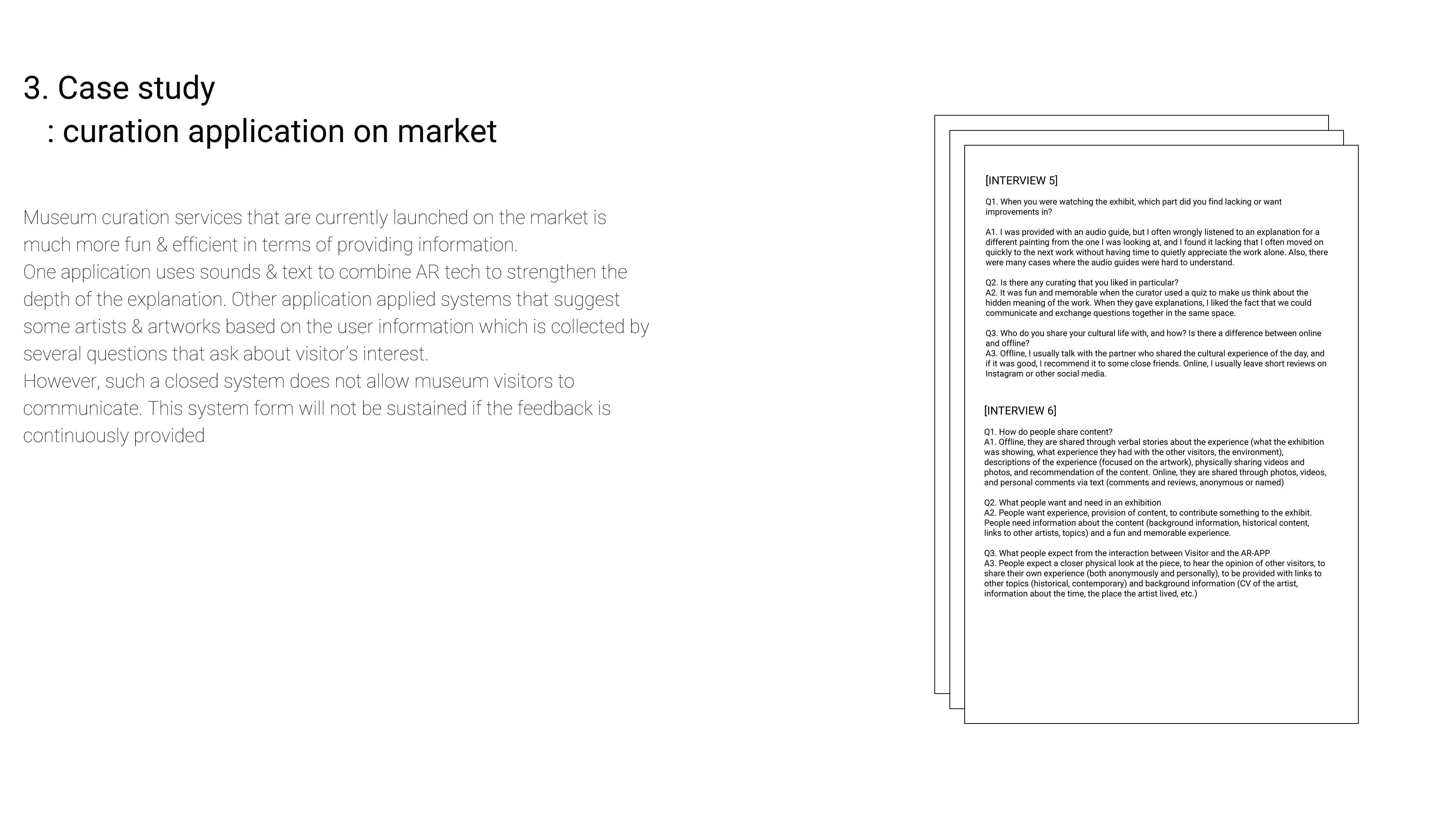10. MUSEEUM
Basically, MUSEEUM is to let people see wider and deeper in the museum so they can be more interested, but less narrow minded in history. And beyond that, we hope they can throw a question before leaving, because questioning means that you know what you understand and not, and above all, it means that it wasn't that boring in the museum.

Introduction

Overall User Flow
‘Museeum’ opens the opportunity to expand the user’s own appreciation experience by triggering them to think and ask once more about the hidden context in the museum. It is also for museum staffs since the application can do a job for them since the app has ‘Curated Information’ of each artifact. ‘Curated Information’ includes restoration function and official texts and audio guide from the museum. By AR restoration function, users can easily imagine life in the past and get the opportunity to make a direct comparison between their own imagination and historical facts. After viewing ‘Curated Information’, every single user can make historical questions through the application, and users with historical knowledge can leave appropriate answers to each question. Sharing each thought via the ‘Questioning and Answering’ system, users can expand their point of view.

Curated
Curated Information ,designed to support users' contextual understanding of history, Provides various historical contexts & perspective to users by various AR-based functions. Curated Information consists of Restoration (function that expands the temporal and spatial context of the displayed items through AR technology) and Exploration function that explains user the context of the exhibition through text and audio.



communicational information
In case of “communicational information” You can ask questions or get answers to specific objects. These Q&A contents overlaps with the layers where we previously described on Explanation existed.
Refined Information selected by curators appears on your screen. This allows the audience to understand the deeper context & background history of the work. Via AR screen. images, videos, hyperlinks, etc. appear in a comprehensive way. And these contents gives user much more active and fun feelings during teaching new information



Blueprint
When designing MUSEEUM, There were two main functional axes that we primarily considered on the entire production process.
First is “Curated information”.
Curated informations are designed to support visitors to better understand historical context ; easier and deeper.
Second ”Communicational Information”
This Information is more focused on facilitating visitors interactive communicatio ; especially triggering users to Ask about historical factors.
Two functions are independently controlled but at the same time, both functions are naturally harmonized Under purpose to provide more meaningful appreciation experience for users.


Background
History is such a precious asset to human-beings. We believe that when many people enjoy, share, and understand that asset ‘socially’, history could bring us a greater value of ‘good influence’. We started our project to find good solutions to make people better understand & expand their own history.
However, current museum system is too closed and passive to enjoy ‘history’ as a pleasant culture. Since most artifacts are untouchable and difficult to access, it is difficult for the audience to understand the ‘context’ of history. Also, because most of the museums use monotonous text-based descriptions on their exhibition, ‘history’ gets hard and boring for visitors who are not familiar with history. On the other hand, since there are few opportunities to deeply think and ask about historical context, it is hard for most of the citizens to see both macro & micro perspectives of history. ‘Museeum’ is designed for all museum visitors who are having difficulties understanding historical context, and people who are willing to get a deeper appreciation of history. By AR-based explanation options and open space for Q&A communication, we tried to make better solutions that could widen the user’s perspective by maximizing their experience.



Research





While designing, we focused on using augmented reality as a tool to make people better understand the context. We categorized second layer of augmented reality in 3. Expanding time, space, and context. Expanding time means restoring ancient objects to their origin appearance with of augmented reality, by sliding the timeline back and forth, user can see the whole, intact version of the damaged artifact nowadays in the museum. Expanding space means viewing other country’s contemporary history, so that the users can broaden their understanding by comparing, for example contemporary map from different countries, user can actually see the difference between cultures and the degree of development. Expanding context means translating old and forgotten languages to the languages of our time.
